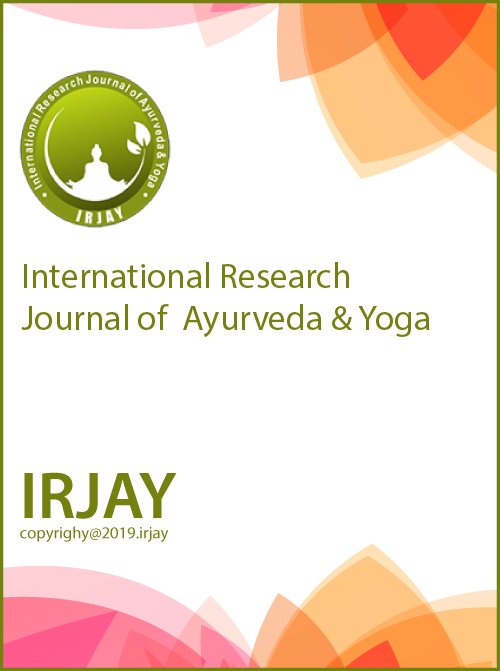A Review Article on dose of Matra Basti
DOI:
https://doi.org/10.48165/Keywords:
Matra Basti, Importance and Properties of Matra Basti, DoseAbstract
Panchakarma presents a unique approach of Ayurveda with specially designed five procedure of internal purification of the body through the nearest possible route. These are Vamana, Virechana, Basti, Nasya and Raktamokshana. Ayurveda considers Basti Chikitsa to be one of the most important Panchakarma treatment. The therapeutic oil or herbal decoction is administered through the anal route in Basti Karma. Matra Basti is one among the Sneha Basti. It is termed so because the dose of Sneha used in it is small when compared to the dose of Sneha Basti. Matra Basti that, there is no restriction of food or regimen while administering Matra Basti. It can be administered continuously in all seasons. The term Matra Basti is popular because of its dose only, because Sneha is administered in the Hraswamatra. Here this article has made to know the different dose of Matra Basti as per different Achaya.
Downloads
References
Acharya YT, Susruta, Susruta Samhita-Chikitsastana, Chapter-35 Sloka-3, With the Nibandhasangraha Commentary of Sri Dalhanacharya and the Nyayachandrika Panjika of Sri Gayadasacharya on Nidanastana, Chaukhamba Sanskrit Sanstana, Varanasi,
Reprint-2010.pp.525.
Acharya YT, Agnivesa, Charaka Samhita- Siddistana, chapter-1 sloka-40, Revised By Charaka and Dridhabala with Ayurveda- Dipika commentary, Chaukhamba Prakashan, Varanasi, Reprint 2009.pp.683.
Shastri AD, Sushruta samhita of maharsi sushruta, Chikitsastana, Chapter no-35, shloka no-18-19, Varanasi, Chaukhambha Sanskrit Santhan, Reprint-2016.pp.191.
Shastri AD, Sushruta samhita of maharsi sushruta, Chikitsastana, Chapter no-35, shloka no-18-19, Varanasi, Chaukhambha Sanskrit Santhan, Reprint-2016.pp.191.
Acharya YT, Agnivesa, Charaka Samhita- Siddistana, chapter-4 sloka-53, Revised By Charaka and Dridhabala with Ayurveda- Dipikan commentary, Chaukhamba Prakashan, Varanasi, Reprint 2009
Sharma S, Vahata or Vrddha Vagbhata, Astangasamgraha, Sutrastana, chapter-28, sloka-8, with Sasilekha Sanskrit commentary by Indu, Chaukhamba Sanskrit Series Office, Varanasi, Reprint-2008
Sastri H.S Paradakara Bhisagacarya, Vagbhata, Astangahrdaya- Sutrastana chapter-19 sloka-68-69, with the commentaries Sarvangasundara of Arunadatta and Ayurvedarasayana of Hemadri, Chaukhamba Surbharati Prakashan, Varanasi, Reprint 2010
Acharya YT, Agnivesa, Charaka Samhita- Siddistana, chapter-4 sloka-54, Revised By Charaka and Dridhabala with Ayurveda- Dipikan commentary, Chaukhamba Prakashan, Varanasi, Reprint 2009
Sharma S, Vahata or Vrddha Vagbhata, Astangasamgraha, Sutrastana, chapter-28, sloka-8, with Sasilekha Sanskrit commentary by Indu,Chaukhamba Sanskrit Series Office, Varanasi, Reprint-2008
Acharya YT, Charaka Samhita, Siddhi sthana, chapter-4, sloka-52-53, Chaukhambha Sanskrit Bhavan, Varnasi, Reprint -2008 Pg.No-701.
Sharma S, Vagbhat Virachita Astanga Sangraha, Sutrasthan, chapter-28,sloka-8 ,Chaukhambha Sanskrit Bhavan, Varnasi, Reprint- 2006, Pg.No-213.
Sastri S, Astanga Hridayam, Sutrasthan, chapter-19,Sloka
, ,Chaukhambha Sanskrit Bhavan, Varnasi, Reprint 2007, Pg.No-283.
Acharya YT, Charaka Samhita, Sutra sthana,Chapter no 13, Sloka-29, Chaukhambha Sanskrit Bhavan, Varnasi, Reprint-2008, Pg.No-83.
Acharya YT, SushruthaSamhitha Chikistasthana, Chapter 31, sloka-18, Chaukhambha Sanskrit Series, Varanasi, Reprint 1994, Pg.No 526.
Acharya YT, Charaka Samhita, Siddhi sthana, Chapter-4, sloka-53, Chaukhambha Sanskrit Bhavan, Varnasi, Reprint-2008, Pg.No-701.
Shastri P , Sharangadhara samhita ,Uttara khanda, chapter 5, Sloka-5, , Chaukhambha Orientalia , Varnasi, Reprint 1983,Pg. No-320.
Bhishagacharya S, Kashyapa Samhita ,Siddhi Sthana ,Chapter-1, sloka-11-20, Chaukhambha Sanskrit Bhavan, Varnasi, Reprint -2006, Pg.No-147.
Bhishagacharya S, Kashyapa Samhita , Khila Sthana ,Chapter-8, sloka-104-105, Chaukhambha Sanskrit Bhavan, Varnasi, Reprint -2006, Pg.No-285.
Shastri AD, Sushruta samhita of maharsi sushruta, Chikistasthana, Chapter no-37, shloka no-14, Varanasi, Chaukhambha Sanskrit Santhan, Reprint-2016, Page no 197.
Shastri , Sharangadhara samhita ,Uttara khanda, Chapter 5, sloka-4-5, Chaukhambha Orientalia , Varnasi , Reprint - 1983,Pg. No-320.
Sharma P,Acharya Chakrapanidatta , Chakradatta , 72(Anuvasanadhikara)/4 , Chaukhambha Sanskrit Bhavan, Varnasi ,Pg. No-619.
Sexena N,Acharya Vangasena , Vangasena Samhita,vol2 ,79/20-22, Chaukhambha Sanskrit Bhavan, Varnasi , Reprint -2004, Pg. No-1147.

